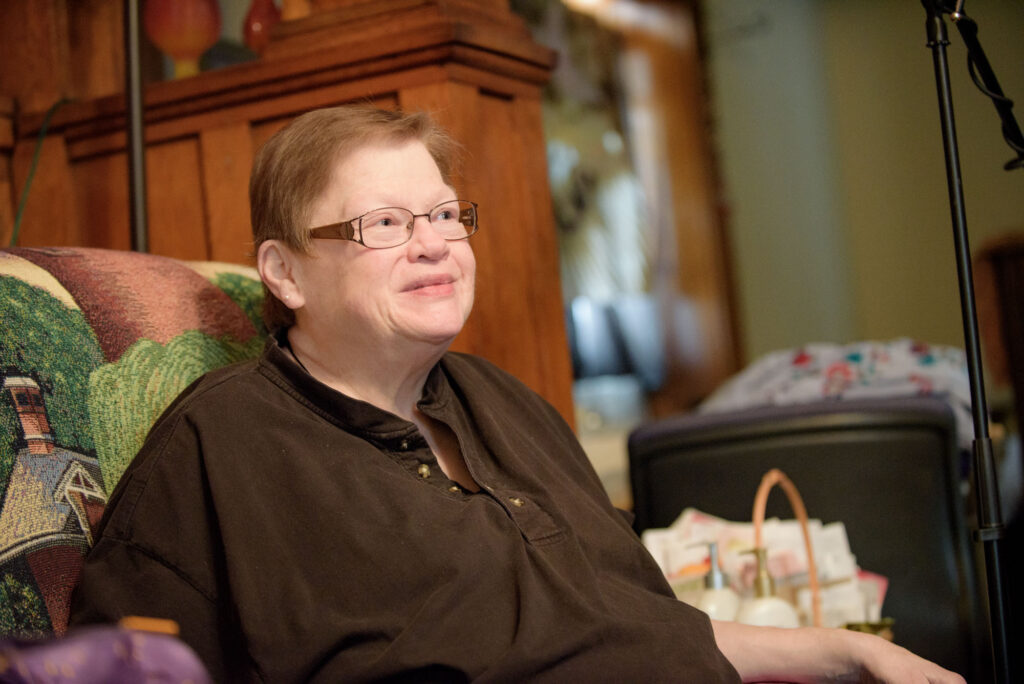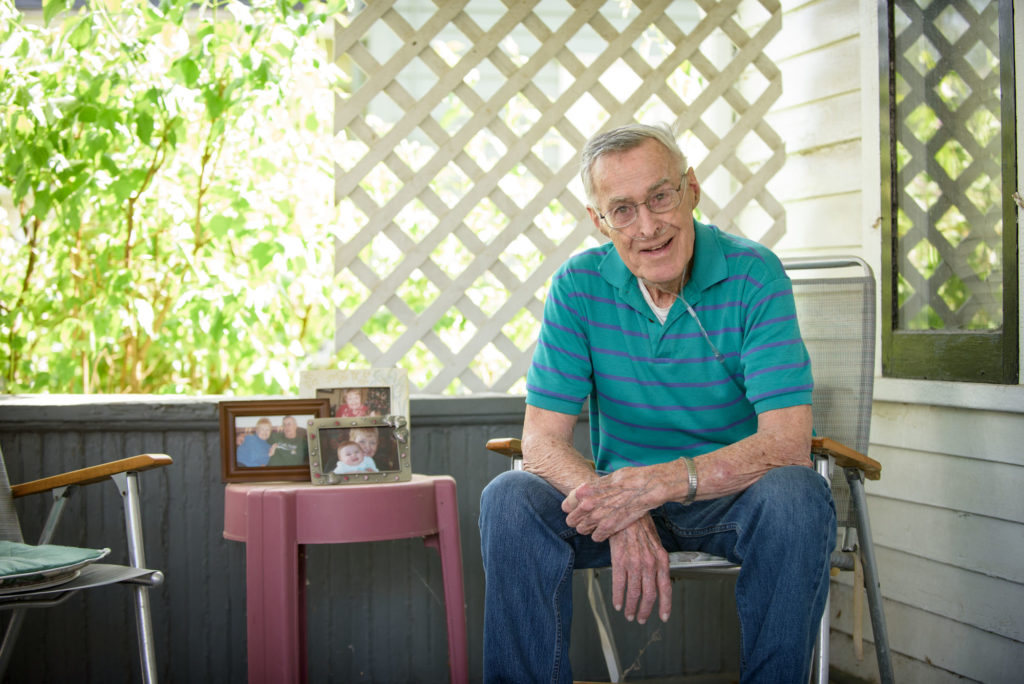Aging in Place: Seniors find solace, services in their home

Colleen Shaffer settles into her favorite chair in the corner of the living room. As her home health aide runs the vacuum across the floor, excited chirps emerge from a cage. It's Colleen's blue parakeet, Baby, who she says is infatuated with noisy appliances.
Colleen, 66, lives in her childhood home in Akron's North Hill neighborhood. She moved back after her parents passed away. Although she's disabled, Colleen is adamant that this will be the last house she lives in. "My mom left the house to my younger sister and I, and I've been here ever since. And I'll probably be here until the good Lord takes me," she said.
Her home health aide helps with household chores like vacuuming, laundry, dishes and some basic cleaning. For Colleen, the extra assistance makes all the difference. She uses a walker at home, and even though she can't drive, she still gets out of the house. "I take my electric wheelchair when the weather's really good, and I go visit neighbors," she said. "I ride the electric wheelchair up to the library, and we get tapes, so we have a good experience 'walking.'"
On the other side of Summit County, Barberton resident Don Nott, 79, sits with his cat on his lap. Like many of his human peers, the cat is blind and is quickly losing its hearing. Don, however, still has enough vision to drive. Among his passengers is his 83-year-old sister, whose macular degeneration robbed her of her license.
"I take my sister everywhere," Don said. His COPD forces him to wait in the car. "I can't get in any stores and walk around with this thing," he complained, pulling on his oxygen tank hose. Don says he's thankful he can remain in his home, where he and his late wife raised two children.
Don and Colleen are part of a growing trend of local seniors who prefer to "age in place" within their own familiar home and community.
A population boom, a stakeholder solution
According to an Akron Community Foundation report, "Creating Measurable Impact," Summit County's population of residents age 60 and older is expected to reach 30 percent in 2030, up from 20 percent in 2010. Add to this rising assisted living costs and seniors' growing preference to remain in their homes, and the demand on service providers is increasing rapidly.

In response, the community foundation convened a coalition of more than 60 stakeholders and senior services providers in 2016 to address the issue. The coalition's No. 1 priority is helping seniors age in their homes, regardless of their ability to pay.
Heading the initiative is Direction Home Akron Canton Area Agency on Aging & Disabilities, which already connects seniors to a centralized suite of services. According to Direction Home CEO Gary Cook, the issue of funding is a major question that, in large part, remains unanswered.
"The aging of Ohio's population will exacerbate the already taxed system that supports older adults," Cook said. "Most individuals do not realize that long-term care and related services are not covered by Medicare. Despite this fact, such care will be necessary for many older adults who have the misfortune to have chronic illnesses. Medicaid currently covers long-term care for those eligible; however, it is only available after virtually all assets are depleted, and Medicaid itself is facing major cuts, which may destroy that entitlement. To truly meet the needs of older adults, we must shore up the systems in place to keep them at home, where they want to stay."
One organization at the core of Direction Home's referral program is Mature Services, which – like many other agencies – is adapting to meet the growing demands of Summit County's aging-in-place population. Colleen and Don consider the agency a "godsend" for allowing them to live and thrive at home despite their physical limitations. But, in many cases, Mature Services' home health aides serve a much greater purpose than simply meeting seniors' physical needs.
"It feels good to help people who aren't able to do (things) for themselves, yet still (want to) stay at home," said Kim Stone, Colleen's home health aide. "It's a treat for me," she added, explaining her philosophy is to treat her clients the same way she would treat her own mother. "If this was my mom, I'd do what I have to do with my mom. I love Colleen," she said.
Social connection over a cup of coffee
After losing his longtime corporate job at BFGoodrich, Don decided to open a coffee shop in 1984 right up the street from his Barberton home. He ran the business for 26 years until, in 2010, the owner had to give the building back to the bank, forcing Don to close his doors.
Don doesn't see the allure of the pricey flavored coffees that are so popular today, but he appreciates that coffee "gives people a chance to get together."
A cup of coffee still keeps Don connected to his own friends. Nearly every morning, he goes to a local fast food restaurant to meet with a small group of seniors who gather for conversation and companionship. Unfortunately, this unconventional family is beginning to dwindle. "We started with about 14, now we're down to six," Don said. "I met some good people (from) all different types of walks of life."
One potential downside to independent living is the risk of losing social connections, which can be detrimental to the physical health of aging adults. Ensuring seniors maintain a healthy social life is important to agencies like Mature Services, Catholic Charities and Direction Home Akron Canton.
"I think it's real important," says Colleen. "I think that people that stay in and do not communicate with neighbors, or even get on the phone and talk with friends, they're missing a lot out of life. I think it makes them a little sicker, too."
While most assisted living facilities have a built-in social component, seniors who choose to age in their homes often have difficulty traveling to visit friends and family. Take Colleen, for example. While she lives independently, she can't afford transportation for anything other than medical visits, which are covered due to her disability. "I use transportation to go back and forth to doctors and the dentist, but I can't visit my friends in Medina and Lodi because I can't afford it," she said. "That's a lot of money."
Carl Bako, development director at Catholic Charities of Summit County, says socialization, transportation and health and wellness have become a critical part of the agency's services. Their Adult Day Services program, now in its 40th year, is designed to improve older adults' independence and socialization through activities that strengthen their physical and mental functioning.
The program accommodates seniors with all levels of function, from alert and highly active participants to those in the advanced stages of Alzheimer's disease. Such services are essential not only for older adults, but also for the people who care for them. "The program helps to bolster the role and ability of the caregiver by providing opportunities for respite and support," Bako explained.
The gap population
Services that help seniors remain independent as well as mentally and physically healthy are necessary for success. But, as with everything, money ultimately drives the level of support available and who receives it. Akron Community Foundation recently committed up to $200,000 in funding over three years to support senior initiatives, which leaders say is a start. But Dawn Moeglin, director of community engagement for Mature Services, is most worried about finding funding for what she calls the "gap populations."
"These are people that do not meet Medicaid and Medicare eligibility guidelines, yet still have needs for services to stay independent. Deep cleaning, homemaker services, transportation, nutritional support and wellness initiatives are all needs that are not funded by traditional health care insurances," she explained.
With so much government funding in question, senior services providers agree that the community can't simply wait for answers. They must take the lead, potentially in the form of a senior services levy for Summit County.
"Summit County falls in line with the national trend of a shifting age demographic, which shows a tremendous increase in the 60+ population over the next number of years," said Summit County Executive Ilene Shapiro. "It is imperative we continue to focus on innovative and sustainable socioeconomic initiatives and programs that will enable our senior and elderly citizens to live comfortably and securely, and to feel valued in their communities."
Another priority is to create a centralized service hub that provides new channels of collaboration for area service providers.
"(The community foundation's) convening reinforced the need for the greater community to come together to collaborate and support our older adult population," Bako said. "Community engagement and collaboration is necessary for social service providers to effectively address the needs of our aging members," many of whom are at risk of losing critical services.
Meanwhile, Colleen and Don continue to live comfortably at home, thanks to Mature Services and a little help from their friends.
"I've been with Mature Services for 20-plus years," Colleen said. "They have helped me so I don't have to go into assisted living, which is very important to me – to all of us, really. I think everybody wants to stay home for as long as they can."
